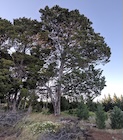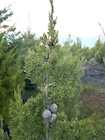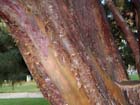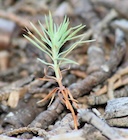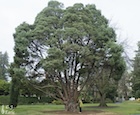Conservation Status

Hesperocyparis guadalupensis
(S.Watson) Bartel (2009)
Common names
Guadalupe island cypress, cedro de la isla Guadalupe [Spanish].
Taxonomic notes
Type: Mexico, Baja California Norte, Isla Guadalupe, E. J. Palmer 92 (lectotype K). Synonymy: see POWO (accessed 2023.12.16). See Hesperocyparis for a discussion of the relationship between this and other, closely related Hesperocyparis taxa in northwest Mexico and the adjacent Southwest U.S. Some authors have treated this as a variety of H. forbesii, but that has not been supported by molecular analyses (Little 2006, Terry et al. 2016). Past authors (Wolf 1948, Little 2006) have found consistent morphological, chemical, phenological, and molecular genetic differences between H. forbesii and H. guadalupensis, but the two species are difficult to distinguish using field characters in an artificial setting such as an arboretum.
Description
Evergreen large shrubs, or trees to 20 m tall and 50 cm dbh, usually smaller in habitat, trunk usually short and forking low, or with multiple trunks; crown highly variable from fastigiate (most common in saplings) to broad and rounded, but usually irregular. Bark smooth, thin, often reddish-brown, often bright but usually fading towards gray, exfoliating in thin flakes or small curling strips. Twigs slender, lax to stiff, ultimate branchlets 3-15 × 1.2-1.7 mm, quadrangular, covered with leaves. Leaves scale-like, opposite in 4 rows, appressed on small twigs, rhombic, 1-1.5 × 1 mm (but up to 15 × 4 mm on some vigorous whip shoots), margins hyaline-denticulate, apex obtuse bright green, usually lacking a glandular dot or whitish dried resin. Pollen cones numerous, terminal, solitary, ovoid-oblong, quadrangular in cross-section, 5-7 × 2-3 mm, with 16-18(-20) microsporophylls. Seed cones terminal, not aggregated but often in loose groups of up to 20 cones, developing over 2 growing seasons; at maturity (sub-)globose, 30-35(-45) mm diameter, serotinous, rugose, dull brown or gray at maturity, composed of (6-)8-10 bract-scale complexes. Seeds numerous, up to 120 per cone, slightly flattened, 4-7 × 2-3.5 mm, dark brown with a lighter hilum, with 2 wings 0.5-1 mm wide (Vidakovic 1991, Nearctica 2000, Farjon 2010). See García Esteban et al. (2004) for a detailed characterization of the wood anatomy.
Seeds of H. guadalupensis and H. forbesii are the same color, but seeds of C. guadalupensis have a glaucous bloom and those of C. forbesii are shiny (Wolf 1948).
There are about 55,000 seeds/kg, which makes them 2-7 times as heavy as seeds of other North American species of Cupressus (Johnson and Karrfalt 2008).
Distribution and Ecology
Mexico: Baja California Norte: endemic to Guadalupe Island, at elevations of 1040-1230 m (see the link for general information on climate, soils, and plant communities). The island is a desert with moisture chiefly provided by fogs, which limit the species' distribution to relatively high elevations (Instituto Nacional de Ecología 2002). For many years the species was further and more severely limited by the grazing of goats, which nearly eliminated the species from the southern half of the island (where it was formerly abundant) and reduced its population to about 3300 individuals on about 160 ha, with negligible regeneration. However, in 2005, under the leadership of Dr. Alfonso Aguirre Muñoz, the Grupo de Ecología y Conservación de Islas, A.C. succeeded in completely eradicating the goats from this large island and the trees and vegetation are now recovering (email, Aguirre Muñoz, 2012.03.01; Mata Flores 2013). As shown in the photos at right (2020's), there is now abundant regeneration in varied size classes. Much of this regeneration happened in response to a September 2008 fire (Mata Flores 2013). Guadalupe Island is also home to the equally rare and endangered Pinus radiata var. binata, but the two species do not occur together.
Native occurrences of H. guadalupensis based on GBIF Occurrence Download
https://doi.org/10.15468/dl.2dzb9t (2025.03.25). Click on a point for more information.
Guadalupe cypress is listed by the IUCN as endangered, but the 2011 analysis conflates this species with C. forbesii and states "population is severely fragmented and there are significant continuing declines and fluctuations in mature individuals due to the increasing frequency of fires" (Farjon 2013). This analysis is wholly incorrect. The population is not fragmented simply because it is so small, and thus far it has largely escaped fires. More importantly for the species, the fires have very low potential to cause extinction; the 21st century fires that have devastated so many California cypresses have also shown that these taxa are all very well adapted to rapid recovery after stand-destroying fire. Nonetheless, the species' extremely small areas of occurrence and of occupancy support a conservation status of "Endangered" or "Critically Endangered" under IUCN criteria. This species is also listed as endangered by the Mexican government (NOM-ECOL-059-94). The island itself has long been protected under various conservation designations and is managed for protection of, among other things, its rare conifers.
Remarkable Specimens
The largest known is a Fresno, California tree 21 m tall and 163 cm dbh (California Registry of Big Trees 2003). A number of cultivated trees are larger than any tree in the species' native habitat; see the bottom photo at right for an example.
Ethnobotany
The species has been in cultivation since about 1879 but is not frost tolerant; it is limited to Zone 9 (cold hardiness limit between -6.6°C and -1.1°C) (Bannister and Neuner 2001). Also, it is not known to set seed outside of habitat (Johnson and Karrfalt 2008), thus it is rarely used as an ornamental.
Observations
The type variety can only be seen on Guadalupe Island. Visiting the island is difficult; in the past it has often required a permit from the Mexican government, and there are no commercial transit services, so access is via private boat or plane. There are also no commercial services on the island.
Remarks
The epithet refers to the Isla Guadalupe.
Citations
Bartel 2009 is in Adams, R.P., J.A. Bartel and R.A. Price. 2009. A new genus, Hesperocyparis, for the cypresses of the western hemisphere. Phytologia 91(1):160-185.
California Registry of Big Trees. 2003. http://www.ufei.org/bigtrees/bigtreelist.lasso, accessed 2003.05.04, now defunct.
Farjon, A. 2013. Cupressus guadalupensis. The IUCN Red List of Threatened Species 2013: e.T42220A2962608. https://dx.doi.org/10.2305/IUCN.UK.2013-1.RLTS.T42220A2962608.en, accessed on 2025.03.25.
Johnson, L. C. and R. P. Karrfalt 2008. Cupressus L. Pp. 459-465 in Bonner, F.T. (tech. ed.). 2008. Woody plant seed manual. USDA Agriculture Handbook 277. Available: https://www.fs.usda.gov/nsl/nsl_wpsm.html, accessed 2025.03.25.
Little, D. P. 2006. Evolution and circumscription of the true cypresses (Cupressaceae: Cupressus). Systematic Botany 31(3):461–480.
Mata Flores, G. G. 2013. Evaluación de la captura de carbono en un bosque de ciprés de Guadalupe (Cupressus guadalupensis) en Isla Guadalupe, Baja California. Thesis, Universidad Autónoma de Nuevo León. Available: http://eprints.uanl.mx/3567/1/1080256589.pdf, accessed 2025.03.25.
Nearctica. 2000. Nearctica - Native Conifers of North America - Cupressus guadalupensis. http://www.nearctica.com/trees/conifer/cupress/Cguada.htm, accessed 2007.01.01, now defunct.
Terry, Randall G., Matthew I. Pyne, Jim A. Bartel, and Robert P. Adams. 2016. A molecular biogeography of the New World cypresses (Callitropsis, Hesperocyparis; Cupressaceae). Plant Systematics and Evolution 302:921–942. https://doi.org/10.1007/s00606-016-1308-4.
Watson, Sereno. 1879. Contributions to American botany. II. Descriptions of some new species of North American plants. Proceedings of the American Academy of Arts and Sciences 14:288-303 (p. 300).
Wolf, C.B. 1948. Taxonomic and distributional studies of the New World cypresses. Aliso 1:1-250.
See also
The species account at Threatened Conifers of the World.
Aguirre-Muñoz, A., A. Samaniego-Herrera, L. Luna-Mendoza, A. Ortiz-Alcaraz, M. Rodríguez-Malagón, M. Félix-Lizárraga, F. Méndez-Sánchez, R. González-Gómez, F. Torres-García, J.C. Hernández-Montoya, J.M. Barredo-Barberena, and M. Latofski-Robles. 2011. Eradications of invasive mammals on islands in México: the roles of history and the collaboration between government agencies, local communities and a non-government organization. Island Invasives: Eradication and Management. Proceedings of the International Conference on Island Invasives. Gland, Switzerland: IUCN and Auckland, New Zealand: CBB. xii + 542pp. Available: issg.org.
Moran, R. 1996. The flora of Guadalupe Island, Mexico. San Francisco: California Academy of Sciences.
Oberbauer, Thomas A., Luciana Luna Mendoza, Nadia Citlali Olivares, Lucía Barbosa Deveze, Isabel Granillo Duarte, and Scott A. Morrison. 2009. Fire on Guadalupe Island reveals some old wounds, and new opportunity. Fremontia 37(3):2-11. Available cnps.org/wp-content/uploads/2018/03/Fremontia_Vol37-No3.pdf, accessed 2023.12.17.

